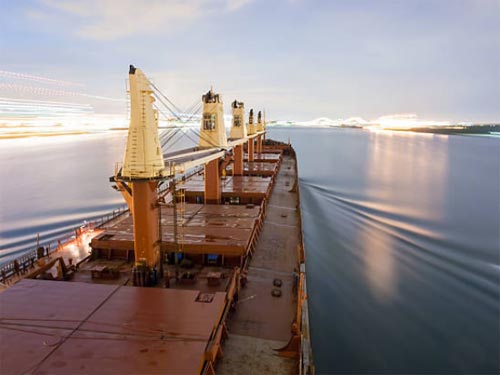Bulk Carriers: The Backbone of Global Commodity Transport

Bulk carrier is a type of large cargo ship specifically designed to transport unpackaged bulk commodities, such as coal, grain, iron ore, cement, and other raw materials. Unlike container ships that carry goods in individual containers, bulk carriers carry goods in large quantities, often in loose form, without packaging.
Here are some key features of a bulk carrier:
Design
Bulk carriers have a large, open cargo hold with multiple compartments (called cargo holds) designed to store the bulk materials. These holds are often fitted with hatches that can be opened and closed to facilitate loading and unloading.
Types of Bulk Carriers
Handysize:
Smaller bulk carriers, typically with a capacity of 10,000 to 40,000 deadweight tons (DWT). They can navigate smaller ports and canals.
Supramax:
Medium-sized bulk carriers, ranging from 50,000 to 60,000 DWT.
Panamax:
Bulk carriers designed to fit the size restrictions of the Panama Canal, usually between 60,000 and 80,000 DWT.
Capesize:
Large bulk carriers, typically over 150,000 DWT, too large to pass through the Panama Canal. They are often used to carry bulk commodities like iron ore and coal over long distances.
Cargo
Bulk carriers are used to transport a wide variety of goods, including:
- Grains: Wheat, corn, rice, and other agricultural products.
- Minerals: Iron ore, bauxite, coal, and other ores.
- Cement: In bulk form for construction and industrial use.
- Other Dry Bulk: Salt, fertilizers, and even steel products.
Loading and Unloading
Bulk carriers are typically loaded and unloaded using specialized equipment such as cranes, conveyor belts, or hoppers at port facilities. The process can take several hours, depending on the cargo and the size of the ship.
Size and Capacity
Bulk carriers vary widely in size, from smaller vessels with a capacity of around 10,000 DWT to larger ones with capacities of up to 400,000 DWT or more. The size of the bulk carrier depends on the type of cargo being transported and the port infrastructure.
Operations
Bulk carriers usually operate on specific trade routes that link major producing regions (such as Australia, Brazil, or the U.S.) with consumer markets around the world. They often make regular trips between ports to deliver essential raw materials.
Fuel Efficiency
Bulk carriers are designed for maximum cargo capacity and fuel efficiency. Since they transport large quantities of goods over long distances, minimizing fuel consumption is critical to their operational costs.
Overall, bulk carriers play a vital role in global trade by transporting raw materials and commodities essential for industries like construction, energy production, and agriculture.
Search Jobs
Seagoing Jobs
- Deck Officer Jobs (42)
- Deck Rating Jobs (5)
- Engineering Officer Jobs (51)
- Engineering Rating Jobs (1)
- Catering Rating Jobs (1)
- Specialist Jobs (2)
- Other Maritime Jobs (33)
Shore Side Jobs
- Shore Side Jobs (18)
Offshore Jobs
- Offshore Jobs (5)
- Drilling / Rig Jobs (0)
- ROV/Diving Jobs (1)
- Production Jobs (0)
- Oilfield Services Jobs (0)
- Procurement & Construction Jobs (0)
- Engineering & Science Jobs (0)
- Geosciences Jobs (0)
- Maintenance & Inspection Jobs (0)
- Health, Safety & Environment Jobs (2)
- Refining & Petrochem Jobs (0)
- Business, IT, HR & Admin Jobs (0)
- Trades & Technicians Jobs (2)
- Other Offshore Jobs (0)

Share this page: